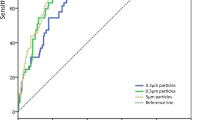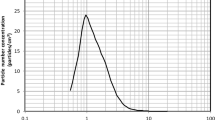Abstract
A 12-week environmental study was performed to ensure that the patient rooms of an SCT ward with high-efficiency particulate air (HEPA) filtration remained uncontaminated by moulds during close-by construction work. The sampling included measuring the ventilation channel pressure, particle count measurements, air sampling, settled dust analysis and fungal cultures from the oral and nasal cavities of the patients. No changes in the air pressure occurred. Median particle counts in patient rooms were 63–420 particles/l. The mean particle count of the outside air was173 659 particles/l. Patient room air samples were negative for aspergilli in 32 of 33 cases. All samples of the outside air were positive for moulds. Aspergillus fumigatus was isolated at the beginning of excavation works at the construction area and in two of 33 dust samples from patient rooms. All 70 nasal samples were negative. Of 35 mouth samples, one sample was positive for A. niger in a patient with a previously diagnosed aspergillus infection. During a median follow-up of 214 days, no invasive aspergillus infections were diagnosed in the 55 patients treated during the construction period. In conclusion, the HEPA filters seemed to have performed well in preventing an aspergillosis outbreak.
This is a preview of subscription content, access via your institution
Access options
Subscribe to this journal
Receive 12 print issues and online access
$259.00 per year
only $21.58 per issue
Buy this article
- Purchase on Springer Link
- Instant access to full article PDF
Prices may be subject to local taxes which are calculated during checkout
Similar content being viewed by others
References
Wald A, Leisenring W, van Burik JA, Bowden RA . Epidemiology of aspergillus infections in a large cohort of patients undergoing bone marrow transplantation. J Infect Dis 1997; 175: 1459–1466.
Marr KA, Carter RA, Crippa F, Wald A, Corey L . Epidemiology and outcome of mould infections in hematopoietic stem cell transplant recipients. Clin Infect Dis 2002; 34: 909–917.
Jantunen E, Nihtinen A, Volin L, Juvonen E, Parkkali T, Ruutu T et al. Candidaemia in allogeneic stem cell transplant recipients: low risk without fluconazole prophylaxis. Bone Marrow Transplant 2004; 34: 891–895.
Herbrecht R, Denning DW, Patterson TF, Bennet JE, Greene RE, Oestman JW et al. Voriconazole versus amphotericin B for primary therapy of invasive aspergillosis. N Engl J Med 2002; 347: 408–415.
Cornet M, Fleury L, Maslo C, Bernard JF, Brucker G, Invasive Aspergillosis Surveillance Network of the Assistance Publique-Hopitaux de Paris. Epidemiology of invasive aspergillosis in France: a six-year multicentric survey in the greater Paris area. J Hosp Infect 2002; 51: 288–296.
Shaukat A, Bakri F, Young P, Hahn T, Ball D, Baer MR et al. Invasive filamentous fungal infections in allogeneic hematopoietic stem cell transplant recipients after recovery from neutropenia: clinical, radiologic, and pathologic characteristics. Mycopathologia 2005; 159: 181–188.
Leenders AC, van Belkum A, Behrendt M, Luijendijk A, Verbrugh HA . Density and molecular epidemiology of aspergillus in air and relationship to outbreaks of aspergillus infection. J Clin Microbiol 1999; 37: 1752–1757.
Oren I, Haddad N, Finkelstein R, Rowe JM . Invasive pulmonary aspergillosis in neutropenic patients during hospital construction: before and after chemoprophylaxis and institution of HEPA filters. Am J Hematol 2001; 66: 257–262.
Rhame FS . Prevention of nosocomial aspergillosis. J Hosp Infect 1991; 18 (Suppl A): 466–472.
Sarubbi FA, Kopf HB, Wilson MB, McGinnis MR, Rutala WA . Increased recovery of Aspergillus flavus from respiratory specimens during hospital construction. Am Rev Respir Dis 1982; 125: 33–38.
Arnow PM, Sadigh M, Costas C, Weil D, Chudy R . Endemic and epidemic aspergillosis associated with in-hospital replication of aspergillus organisms. J Infect Dis 1991; 164: 998–1002.
Thio CL, Smith D, Merz WG, Streifel AJ, Bova G, Gay L et al. Refinements of environmental assessment during an outbreak investigation of invasive aspergillosis in a leukemia and bone marrow transplant unit. Infect Control Hosp Epidemiol 2000; 21: 18–23.
Vonberg R-P, Gastmeier P . Nosocomial aspergillosis in outbreak settings. J Hosp Infect 2006; 63: 246–254.
Ruutu P, Valtonen V, Tiitanen L, Elonen E, Volin L, Veijalainen P et al. An outbreak of invasive aspergillosis in a haematologic unit. Scand J Infect Dis 1987; 19: 347–351.
Cornet M, Levy V, Fleury L, Lortholary J, Barquins S, Coureul MH et al. Efficacy of prevention by high-efficiency particulate air filtration or laminar airflow against Aspergillus airborne contamination during hospital renovation. Infect Control Hosp Epidemiol 1999; 20: 508–513.
Berthelot P, Loulergue P, Raberin H, Turco M, Mounier C, Tran Manh Sung R et al. Efficacy of environmental measures to decrease the risk of hospital-acquired aspergillosis in patients hospitalised in haematology wards. Clin Microbiol Infect 2006; 12: 738–744.
Overberger PA, Wadowsky RM, Schaper MM . Evaluation of airborne particulates and fungi during hospital renovation. Am Ind Hyg Assoc J 1995; 56: 706–712.
Humphreys H, Johnson EM, Warnock DW, Willatts SM, Winter RJ, Speller DC . An outbreak of aspergillosis in a general ITU. J Hosp Infect 1991; 18: 167–177.
Alberti C, Bouakline A, Ribaud P, Lacroix C, Rousselot P, Leblanc T et al. Relationship between environmental fungal contamination and the incidence of invasive aspergillosis in haematology patients. J Hosp Infect 2001; 48: 198–206.
Iwen PC, Davis JC, Reed EC, Winfield BA, Hinrichs SH . Airborne fungal spore monitoring in a protective environment during hospital construction, and correlation with an outbreak of invasive aspergillosis. Infect Control Hosp Epidemiol 1994; 15: 303–306.
Aisner J, Murillo J, Schimpff SC, Steere AC . Invasive aspergillosis in acute leukemia: correlation with nose cultures and antibiotic use. Ann Intern Med 1979; 90: 4–9.
Jeffery GM, Beard ME, Ikram RB, Chua J, Allen JR, Heaton DC et al. Intranasal amphotericin B reduces the frequency of invasive aspergillosis in neutropenic patients. Am J Med 1991; 90: 685–692.
Richardson MD, Rennie S, Marshall I, Morgan MG, Murphy JA, Shankland GS et al. Fungal surveillance of an open haematology ward. J Hosp Infect 2000; 45: 288–292.
Goodman JL, Winston DJ, Greenfield RA, Chandrasekar PH, Fox B, Kaizer H et al. A controlled trial of fluconazole to prevent fungal infections in patients undergoing bone marrow transplantation. N Engl J Med 1992; 326: 845–851.
Slavin MA, Osborne B, Adams R, Levenstein MJ, Schoch HG, Feldman AR et al. Efficacy and safety of fluconazole prophylaxis for fungal infections after marrow transplantation – a prospective, randomized, double-blind study. J Infect Dis 1995; 171: 1545–1552.
Faure O, Fricker-Hidalgo H, Lebeau B, Mallaret MR, Ambroise-Thomas P, Grillot R . Eight-year surveillance of environmental fungal contamination in hospital operating rooms and haematological units. J Hosp Infect 2002; 50: 155–160.
Acknowledgements
We thank hospital infection control nurse Tarja Kuutamo, research nurses Marja Pekkanen and Anne Gesterberg and Mrs Eeva Mäkinen for their contribution to this study.
Author information
Authors and Affiliations
Corresponding author
Rights and permissions
About this article
Cite this article
Nihtinen, A., Anttila, VJ., Richardson, M. et al. The utility of intensified environmental surveillance for pathogenic moulds in a stem cell transplantation ward during construction work to monitor the efficacy of HEPA filtration. Bone Marrow Transplant 40, 457–460 (2007). https://doi.org/10.1038/sj.bmt.1705749
Received:
Revised:
Accepted:
Published:
Issue Date:
DOI: https://doi.org/10.1038/sj.bmt.1705749
Keywords
This article is cited by
-
Primary prophylaxis of invasive fungal infections in patients with haematological malignancies: 2017 update of the recommendations of the Infectious Diseases Working Party (AGIHO) of the German Society for Haematology and Medical Oncology (DGHO)
Annals of Hematology (2018)
-
Invasive Aspergillus infections in allo-SCT recipients: environmental sampling, nasal and oral colonization and galactomannan testing
Bone Marrow Transplantation (2010)
-
References
Bone Marrow Transplantation (2009)



